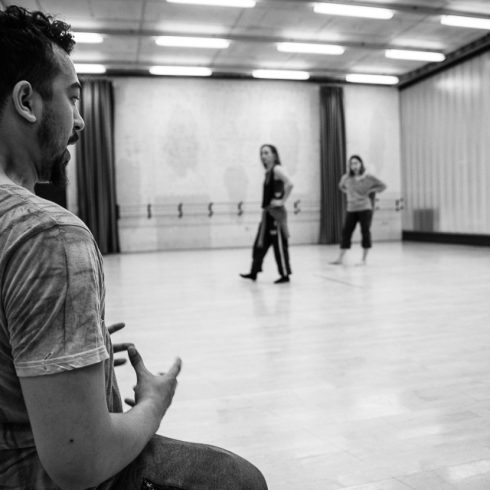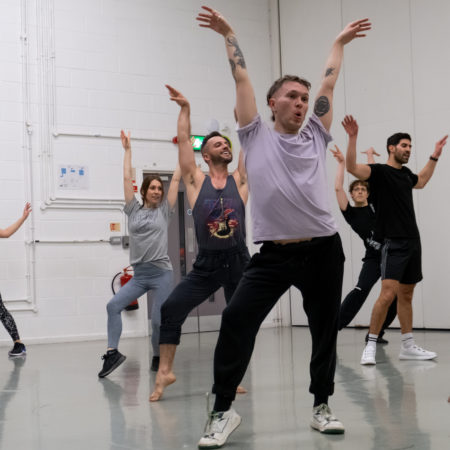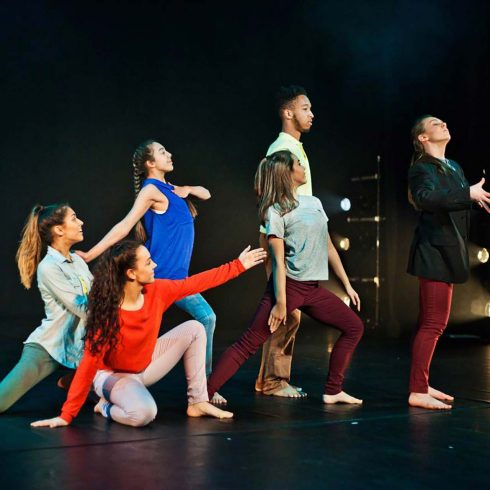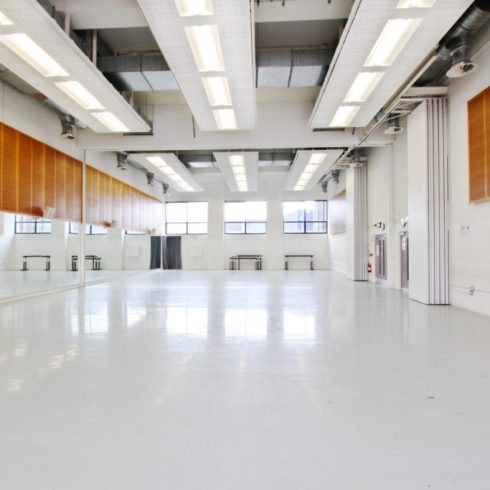SHANE SHAMBHU : 8 – 21 June
As part of the Dance Insights Online programme, 2020 Artist in Residence Shane Shambhu shares an exciting programme offering a unique insight into his creative inspiration. This is the fourth in the series Dance Insights Online – a curated online programme of performances, discourse and events, provocations and artistic inspirations. Each programme will be online for two weeks and offer audiences an insight into the process and mind of the creator.
In the first week Shane will be sharing his film Inner Spaces, and his ‘Revelations’ an insight into work that he has found to be inspirational. Shane has also curated Director’s Cut, a series of short conversations with four artists discussing dance, theatre and culture, perfect for a relaxing break in your afternoon. In week two, Director’s Cut continues and Shane also opens up about his thoughts on the arts in What’s Cooking a podcast commentary as he cooks one of his favourite dishes (see below to follow the recipe and cook along with him), plus spend a day in lock down with Shane on instagram and listen to his choice of incredible music.
WEEK ONE
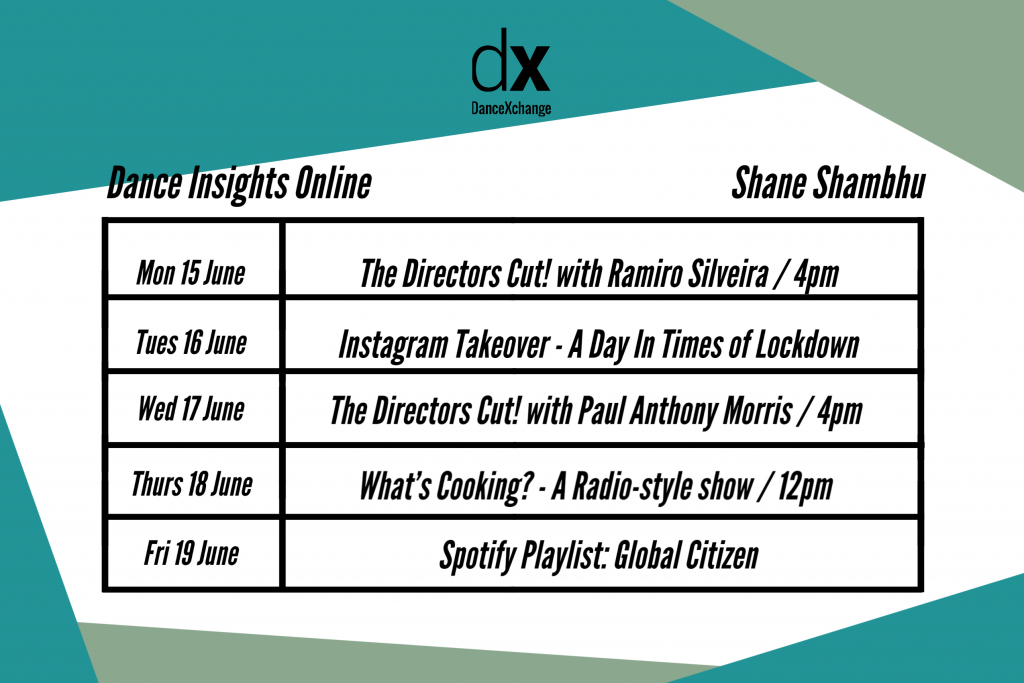
WATCH
INNER SPACES: A CHOREOGRAPHIC JOURNEY
Monday 8 June – available until 21 June
Shane Shambhu walks us through his choreographic research from Bharatanatyam dancer to developing a unique and distinct voice as Creative Director of Altered Skin and reveals what is next as Artist-In-Residence at DanceXchange.
A transcript of the text is available Here
Duration: 20 mins
LISTEN
DIRECTOR’S CUT
Relax with a coffee and a biscuit and be creatively inspired and energised by this series of short conversations expanding our understandings of dance, theatre and culture.
DIRECTOR’S CUT: Shane Shambhu in conversation with Jatinder Verma
Shane Shambhu speaks with acclaimed and noted Theatre Director, Jatinder Verma about process and methodologies, how his practice from Sanskrit Theatre has evolved and they converse on the differences between dance and theatre.
INSPIRE
SHANE’S REVELATIONS
Thursday 11 June
Shane shares some of the writing, people, places and films that have inspired him – there’s even a short quiz!
THE NATYASHASTRA
The Nāṭya Śāstra is a Sanskrit text on the performing arts. It is an ancient encyclopaedic treatise on the arts, one which has influenced dance, music and literary traditions in India. The first complete compilation is dated to between 200 BCE and 200 CE, but estimates vary between 800 BCE and 500 BCE.
The text consists of 36 chapters with a cumulative total of 6000 poetic verses describing performance arts. The subjects covered by the treatise include dramatic composition, the structure of a play and the construction of a stage to host it, genres of acting, body movements, makeup and costumes, the musical scales, musical instruments and the integration of music with art performance.
My entire creative explorations specifically the direction of travel in drama and theatre principles has been guided by this body of the text. It is vast and will be a source of knowledge and inspiration for my lifetime.
BRIDGES
Bridges are such beautiful architectural structures. The designs, the variety and most importantly its purpose, that of connecting one or more places together. This for me is its greatest beauty. A structure which is built to span a physical obstacle, without closing the way underneath. This is something that inspires me both in my work and life. I love standing on bridges, that space in-between, just like the stage where I feel most liberated and connected.
Here are seven bridges I have visited.
See if you can figure out the country and city?

Answers
A.Golden Gate Bridge, San Fransisco, USA
B.Sydney Harbour Bridge, Sydney, Australia
C.Bosphorous Bridge, Istanbul, Turkey
D. Bandra-Worli Sea Link, Mumbai, India
E.Brindley Place, Birmingham, UK
F.Brooklyn Bridge, New York, USA
G.Stari Most, Mostar, Bosnia & Herzegovina
STUART HALL
I came to know of and read about Stuart Hall much later in my life. However, everything he has said about arts and culture I resonate with so deeply. His theories and thinking opened up my understanding of re-presentation and what that means to me and it constantly inspires me to be strong in who I am and why I do what I do.
Stuart Hall was a Jamaican-born cultural theorist and political activist. He was one of the founding figures of the school of thought that is now known as British Cultural Studies. He became the director of The Centre for Contemporary Cultural Studies in 1972. While at the Centre, Hall is credited with playing a role in expanding the scope of cultural studies to deal with race and gender, and with helping to incorporate new ideas derived from the work of French theorists like Michel Foucault. British newspaper The Observer called him “one of the country’s leading cultural theorists” Hall was also involved in the Black Arts Movement.
RUKMINI DEVI-ARUNDALE
Rukmini Devi-Arundale systematically reformed Bharatanatyam, which was originally named ‘Sadhir’ or ‘Dasiattam ‘, which belonged to a community called ‘Devadasi’. The art form and the community it belonged to had fallen into disrepute because the British, during their colonial rule, deemed ‘Sadhir’ too vulgar to be considered an art form. Rukmini Devi-Arundale learnt ballet first, from Anna Pavlova and then learnt ‘Sadhir’ from the community with the sight to profiling Indian arts and culture. Over several years she re-formed ‘Sadhir’ and it was re-named Bharatanatyam. This, in-turn disassociated the art form from the devadasi community to whom this practise belonged to. In making these reforms, Rukmini Devi brought this art form to the world stage and acceptable to the British and the elite of Indian society by removing aspects of eroticism.
Although I recognise the inequality and hierarchical structures created by taking from a community and reforming the practice to present a more acceptable version for the British and elite, it is her strength of vision and courage to take such a bold step that is inspiring. She followed her passion to discover a renewed identity for the arts and culture of a newly independent India. I am deeply upset that the art form has been dissected from the devadasi community. This separation was driven by a number of political agendas from varying groups of peoples at the time.
As a curious person, I would like to know how the art form would have continued evolving from within the Devadasi community. There were many complexities during that time, however, history has led us to this point in time and for me, Rukmini Devi triggers a creative drive and desire in me to continue the renewed Bharatanatyam’s journey by following my own passion to discover a renewed identity for Bharatanatyam within the diaspora, but not just the Asian diaspora all diasporas.
Please note: This short documentary is quite old!
I am fortunate that my family are supportive of my artistic life. Although, it took some time for them to come around. I had to endure the whole “when are you going to get a proper job?” phase. But now, my immediate family have been very supportive but most of all my incredible wife, Deniz Soezen, who is a visual artist. She is a continuous stream of inspiration for me and a pillar of strength. She is my constant sounding board and helps me to the best version of me, both in my work and life.
Take a look at Deniz Soezen work
DIRECTOR’S CUT: Shane Shambhu in conversation with Kristine Landon-Smith
Shane Shambhu speaks with Kristine Landon-Smith her approach to intra-cultural creating and its importance, development of physical actions and abstraction in theatre contexts and why there is a lack of female directors and choreographers.
LISTEN
DIRECTOR’S CUT
Relax with a coffee and a biscuit and be creatively inspired and energised by this series of short conversations expanding our understandings of dance, theatre and culture.
DIRECTOR’S CUT: Shane Shambhu in conversation with Ramiro Silveira
Shane Shambhu speaks with Brazilian-born Theatre Director, Ramiro Silveira about his physical-theatre practises, the relevance of physicality in drama and plays and Brazil’s place on the global stage.
FOLLOW
A DAY IN LOCKDOWN
Tuesday 16 June on Instagram Live
Shane takes over our Instagram account to share his day with you.
DIRECTOR’S CUT: Shane Shambhu in conversation with Paul Anthony Morris Shane Shambhu speaks with Paul Anthony Morris about the importance of dance in his work and it’s relevance and his own unique physical training approach and its effect on actors.
LISTEN
WHAT’S COOKING: an audio cooking show with Shane and an open and honest chat about life in the arts.
Thursday 18 June, 12pm
Shane cooks a South-Indian dish called ‘Aviyal’. Join him in a radio-style cooking show where he talks you through his recipe while speaking candidly about cultural expectations, body image and tokenism in the arts.
If you would like to cook along with Shane, he will be following this recipe
| Mixed Vegetables | Any combination of: carrots, pumpkin, butternut squash, yams, aubergines, green beans, raw banana (green) |
| 2 Small Onions | |
| Garlic | 3 cloves |
| Coconut | Can use coconut cream or coconut milk |
| Turmeric Powder | 1 teaspoon |
| Salt | To taste |
| Cumin Powder/Jeera | 1 teaspoon |
| Plain Yogurt | ¼ cup |
| Green Chillies | 2 |
| Coconut Oil | 3 tablespoons |
LISTEN
MUSICAL INSPIRATION: GLOBAL CITIZEN
Friday 19 June
Grab a drink (or whatever your poison is) and listen to Shane’s eclectic mix of music that will get you dancing, dreaming and drifting.
FIND OUT MORE ABOUT OUR DX DIGITAL DANCE INSIGHTS PROGRAMME HERE.


